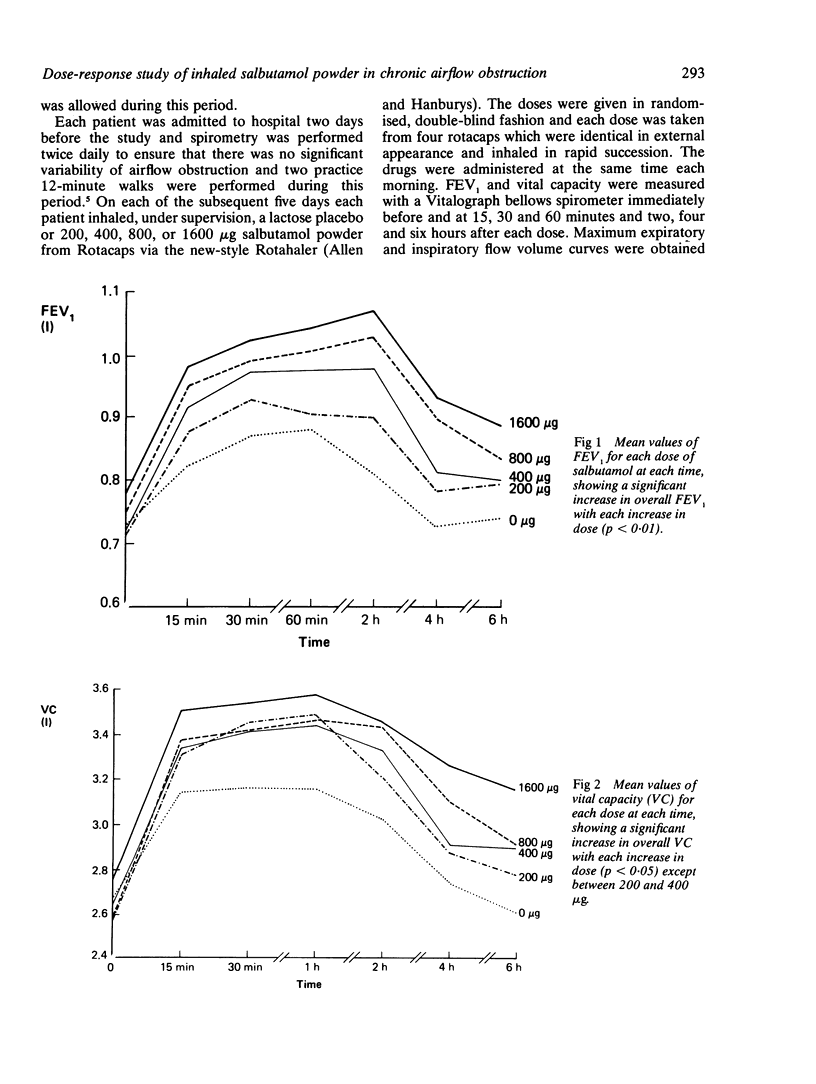Abstract
Dose-response relationships for salbutamol were studied in eight patients suffering from chronic airflow obstruction with no asthmatic features. Each inhaled, double blind, in randomised order 0, 200, 400, 800, and 1600 micrograms salbutamol on five successive mornings. Before and at intervals up to six hours after the inhalation FEV1, vital capacity, maximum inspiratory and expiratory flow-volume curves, and 12-minute walking distances were measured. Analysis of variance of the results indicated significant dose-response relationships and showed the larger doses to have a longer duration of action. Simple spirometric tests were as useful in providing objective evidence of benefit as maximum inspiratory flows or the 12-minute walking distance.
Full text
PDF




Selected References
These references are in PubMed. This may not be the complete list of references from this article.
- Bellamy D., Hutchison D. C. The effects of salbutamol aerosol on lung function in patients with pulmonary emphysema. Br J Dis Chest. 1981 Apr;75(2):190–196. doi: 10.1016/0007-0971(81)90052-8. [DOI] [PubMed] [Google Scholar]
- Cayton R. M., Webber B., Paterson J. W., Clark T. J. A comparison of salbutamol given by pressure-packed aerosol or nebulization via IPPB in acute asthma. Br J Dis Chest. 1978 Jul;72(3):222–224. doi: 10.1016/0007-0971(78)90045-1. [DOI] [PubMed] [Google Scholar]
- Choo-Kang Y. F., Grant I. W. Comparison of two methods of administering bronchodilator aerosol to asthmatic patients. Br Med J. 1975 Apr 19;2(5963):119–120. doi: 10.1136/bmj.2.5963.119. [DOI] [PMC free article] [PubMed] [Google Scholar]
- Connellan S. J., Gough S. E. The effects of nebulized salbutamol on lung function and exercise tolerance in patients with severe airflow obstruction. Br J Dis Chest. 1982 Apr;76(2):135–142. [PubMed] [Google Scholar]
- Holgate S. T., Baldwin C. J., Tattersfield A. E. beta-adrenergic agonist resistance in normal human airways. Lancet. 1977 Aug 20;2(8034):375–377. doi: 10.1016/s0140-6736(77)90304-x. [DOI] [PubMed] [Google Scholar]
- McGavin C. R., Gupta S. P., McHardy G. J. Twelve-minute walking test for assessing disability in chronic bronchitis. Br Med J. 1976 Apr 3;1(6013):822–823. doi: 10.1136/bmj.1.6013.822. [DOI] [PMC free article] [PubMed] [Google Scholar]
- Ramsdell J. W., Tisi G. M. Determination of bronchodilation in the clinical pulmonary function laboratory. Role of changes in static lung volumes. Chest. 1979 Dec;76(6):622–628. doi: 10.1378/chest.76.6.622. [DOI] [PubMed] [Google Scholar]
- Ruffin R. E., Obminski G., Newhouse M. T. Aerosol salbutamol administration by IPPB: lowest effective dose. Thorax. 1978 Dec;33(6):689–693. doi: 10.1136/thx.33.6.689. [DOI] [PMC free article] [PubMed] [Google Scholar]
- Shenfield G. M., Paterson J. W. Clinical assessment of bronchodilator drugs delivered by aerosol. Thorax. 1973 Mar;28(2):124–128. doi: 10.1136/thx.28.2.124. [DOI] [PMC free article] [PubMed] [Google Scholar]


